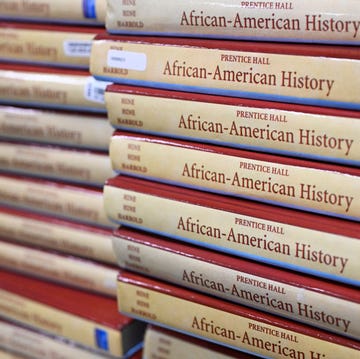This Women’s History Month, as women and queer people in the United States face growing challenges to their bodily autonomy, it’s encouraging to turn to audacious women from the past who also lived through challenging times. My forthcoming book, The Famous Lady Lovers: Black Women and Queer Desire Before Stonewall, is filled with stories of women who surmounted life in the Jim Crow era to craft the relationships they desired, and Gladys Bentley was one of the boldest of them all.
Bentley was the most popular and infamous speakeasy performer in Prohibition-era New York. A large, masculine, Black woman—a “bulldagger,” in the language of her day—she was known for wearing a white tuxedo and top hat onstage while expertly playing the piano and singing dirty versions of popular songs to rapt “slumming” audiences. She even married her white girlfriend in a well-publicized Atlantic City wedding ceremony.
There is a rich history of “male impersonators” on the popular American stage going back to the 19th century, who today are often known as “drag kings.” Some of these performers actively crafted male personae, but others like Bentley used the category of male impersonator just to be their masculine selves, on and off the stage.
More From Harper's BAZAAR

In the 1920s, lesbian identity was just becoming visible in America popular culture, but it was still generally viewed as immoral, criminal, and akin to a mental illness. Despite this, Bentley was able to make a successful living being her openly queer self, a rarity for the time. She made sapphism more visible in a time of changing ideas about sex and gender, as women were entering more professions and having fewer children.
Her performances often involved going into the audience and flirting with all the female patrons. One reviewer wrote she “sang wicked blues in a deep contralto voice” and “bemoaned her girlfriend who had deserted her for another woman.” As Bentley sang, she went from table to table, and “much to the delight of the audience, every once in a while she’d feign recognition only to find disappointment upon closer inspection.” As for her bawdy songs, one included the lyrics, “It’s a helluva situation up at Yale / As a means of recreation / They rely on masturbation / It’s a helluva situation up at Yale.”
The early 20th century was still a conservative time in many ways, but the banning of alcohol from 1920 to 1933 created illicit spaces in northern cities like speakeasies and rent parties, which offered temporary freedom from social norms. Hundreds of thousands of Southern African Americans went to these cities in search of new opportunities, in what became known as the Great Migration. And Black soldiers who had served in World War I came home with a renewed sense of racial pride. This led to an explosion of Black literature, music, art, and performance often referred to as the Harlem Renaissance. All these factors helped make Harlem the epicenter of the era, where Gladys Bentley rose to fame.
Born in 1907, Bentley relocated to New York from Philadelphia as a teenager after her parents kicked her out for being queer. Incredibly talented on the piano, she soon started performing professionally. By the late 1920s, she was so successful that for a while she had a Harlem club named after her, not to mention a Park Avenue apartment, servants, and a beautiful car.
The clubs Bentley performed in offered a form of liberation, but they weren’t entirely free of the oppression of 1920s America. Many of the clubs, like the Cotton Club and the Ubangi Club, had names that smacked of primitivism. Some white liberals in the Jim Crow era believed that Black people were closer to and more in touch with nature, and this desire for authenticity led white “slummers” to visit Harlem dives and seek out blues performances. Visitors from outside the district went to imbibe bootleg alcohol and watch outrageous performances in exotic locales so they could return home and shock their neighbors with their wild uptown exploits.
The visibility of overtly queer figures such as Bentley to the white slumming crowd was an embarrassment to the Black middle class. Critics like W.E.B. Du Bois were concerned that their neighborhoods were being used by white visitors like a trip to the zoo or the circus. He wrote in 1927 that Harlem was “not chiefly cabarets, it is chiefly homes.” Some feared that unconventional figures like Bentley were misrepresenting the race, doing a disservice to the cause of racial uplift and to the dignity of the Black community.
Nevertheless, Bentley became so popular during Prohibition that by the early 1930s, her act headed to Midtown, where her toned-down but still raunchy performances were soon discovered not only by journalists, but by the police as well. In 1934, just after Prohibition’s repeal, she was appearing at the King’s Terrace on West 52nd Street, when complaints made over her “dirty songs” led to her dismissal from the venue, and soon after that, the police padlocked the establishment’s doors.
This is a good example of how Prohibition’s repeal in 1933, the “anything goes” era of bootleg alcohol and speakeasies, gave way to a more conservative era. New state laws were created to control the consumption of liquor and regulate the spaces where it was consumed, and were also used to police the presence of queerness. Those venues seeking to serve alcohol were required to not “suffer or permit such premises to become disorderly.” Though disorderly was not explicitly defined, the State Liquor Authority took this term to imply that the presence of queer patrons, sex workers, gamblers, and other “undesirables” made a venue disorderly.
These ambiguously worded laws that police queer people’s autonomy have returned with a vengeance in the last few years. I’m currently writing this from Tennessee, where public drag performances have just been banned. This wave of anti-LGBTQ legislation is instilling fear not just in drag performers, but in trans and gender-nonconforming people just trying to live their lives.
Bentley’s open queerness in the 1920s and ’30s offers us a model of daring resistance that can inspire us today as we enter a new era of backlash against queer and trans visibility in American society. The most visible members of the queer community have always been on the forefront of the movement and have also received the most vitriol. It’s important to not only hold them up today, but to also learn about the queer past, and Women’s History Month is the perfect time to tell and share their important stories of resistance.

Cookie Woolner is a cultural historian of race, gender, and sexuality in the modern U.S. She is an Associate Professor in the History department at the University of Memphis. Her book, “The Famous Lady Lovers:” African American Women and Same-Sex Desire Before Stonewall, explores the lives of of Black women who loved women in the Interwar era. It will be published in Fall 2023.















